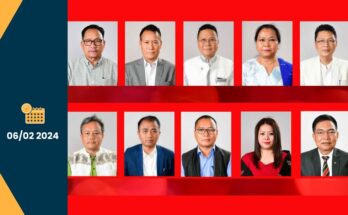
A Comprehensive Guide: How to Earn with Affiliate Marketing
February 9 , 2024 Imphal By Banti Phurailatpam:
In today’s digital era, affiliate marketing has emerged as a prominent avenue for individuals to earn passive income and build profitable online businesses. With the potential to generate commissions by promoting products or services from other companies, affiliate marketing offers a flexible and accessible opportunity for entrepreneurs of all backgrounds. However, achieving success in affiliate marketing requires strategic planning, dedication, and a willingness to learn. In this comprehensive guide, we’ll explore the essential steps and strategies to help you earn with affiliate marketing and unlock your earning potential.
Understanding Affiliate Marketing
Before diving into the practical aspects, it’s crucial to grasp the fundamentals of affiliate marketing. At its core, affiliate marketing involves partnering with companies or merchants to promote their products or services in exchange for a commission on sales generated through your unique affiliate links. These links are tracked using cookies or other tracking mechanisms, allowing merchants to attribute sales to specific affiliates accurately. Affiliate marketing operates on a performance-based model, meaning you only earn commissions when your promotional efforts result in a desired action, such as a sale, lead, or click.
Steps to Earn with Affiliate Marketing
1. Choose Your Niche
Selecting the right niche is a critical first step in your affiliate marketing journey. Your niche should align with your interests, expertise, and target audience preferences. Conduct thorough research to identify profitable niches with a sizable audience and sufficient demand for products or services. Consider factors such as competition level, market trends, and the potential for recurring revenue streams.
2. Research Affiliate Programs
Once you’ve identified your niche, research and evaluate various affiliate programs within that niche. Look for reputable merchants or affiliate networks that offer products or services relevant to your audience. Consider factors such as commission rates, cookie duration, payment terms, and promotional resources provided by the affiliate program. Choose programs that align with your niche and offer competitive commissions while ensuring the quality and relevance of the products or services you’ll be promoting.
3. Build Your Platform
Your platform serves as the foundation of your affiliate marketing efforts and plays a crucial role in attracting and engaging your audience. Depending on your preferences and expertise, you can establish a blog, website, YouTube channel, social media presence, or a combination of these platforms. Focus on creating high-quality, valuable content that resonates with your target audience and addresses their needs, interests, and pain points. Optimize your platform for search engines to improve visibility and attract organic traffic, and leverage social media channels to expand your reach and engage with your audience effectively.
4. Create Compelling Content
Content lies at the heart of successful affiliate marketing campaigns. Develop a content strategy that encompasses a diverse range of formats, including blog posts, articles, videos, podcasts, infographics, and product reviews. Prioritize quality over quantity and strive to deliver informative, engaging, and authentic content that builds trust with your audience. Incorporate your affiliate links naturally within your content, ensuring relevance and transparency to avoid coming across as overly promotional.
5. Implement Effective Promotion Strategies
Promoting your affiliate offers requires a strategic approach tailored to your target audience and chosen platforms. Experiment with various promotion tactics such as SEO, email marketing, social media advertising, influencer partnerships, and content syndication to maximize your reach and drive traffic to your affiliate links. Monitor your promotional efforts closely, track key metrics such as click-through rates, conversion rates, and revenue generated, and refine your strategies based on performance data to optimize your results continuously.
6. Build Relationships and Trust
Building trust with your audience is paramount in affiliate marketing. Focus on fostering genuine relationships based on transparency, authenticity, and credibility. Provide valuable content, offer unbiased recommendations, and disclose your affiliate relationships openly to maintain transparency and integrity. Engage with your audience regularly, respond to their questions and feedback promptly, and demonstrate your expertise and passion for your niche to establish yourself as a trusted authority in your field.
Maximizing Your Earning Potential
1. Diversify Your Income Streams
Explore opportunities to diversify your income streams by promoting products from multiple affiliate programs, experimenting with different niches or markets, and leveraging various promotional channels. Diversification can help mitigate risk and maximize your earning potential in affiliate marketing.
2. Stay Informed and Adapt
Stay updated on industry trends, best practices, and emerging strategies in affiliate marketing. Invest in ongoing education, participate in forums, attend webinars, and network with other affiliates to stay informed and adapt to evolving market dynamics.
3. Analyze and Optimize
Continuously monitor your performance metrics, track key indicators such as click-through rates, conversion rates, and revenue generated, and analyze data to identify trends, patterns, and areas for improvement. Adjust your strategies accordingly to optimize your results and maximize your earning potential over time.
4. Be Patient and Persistent
Building a successful affiliate marketing business takes time, effort, and patience. Stay committed, consistent, and persistent in your efforts, even if you encounter challenges or setbacks along the way. Keep learning, adapting, and refining your strategies to achieve your financial goals and entrepreneurial dreams.
Conclusion
Earning with affiliate marketing requires dedication, persistence, and a strategic approach to maximize your earning potential. By following the steps outlined in this guide and implementing effective strategies, you can build a profitable affiliate marketing business that generates passive income and offers long-term success. Remember to focus on providing value to your audience, building trust and relationships, and staying informed and adaptable as you navigate the dynamic landscape of affiliate marketing. With perseverance and determination, you can unlock the full potential of affiliate marketing and achieve your financial goals on your terms.
A Comprehensive Guide: How to Earn with Affiliate Marketing Read More



















